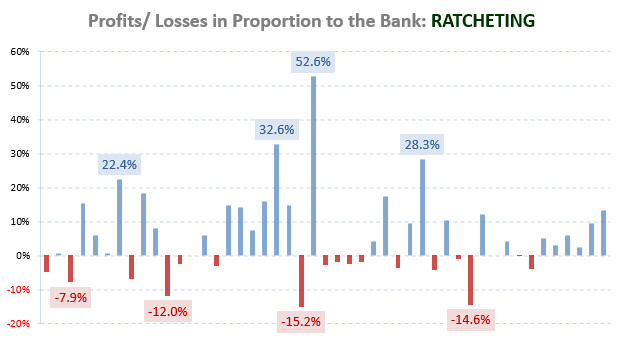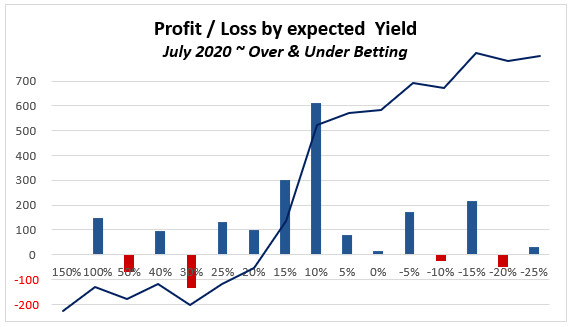
Consciously “Incorrect” Odds on the Market
Odds are adjusted to match public opinion and the betting behaviour of sports fans. This is a fact!
One major reason for this is that most bettors are not mathematicians and most place their wagers based on ‘gut feelings’ (reading about recent form, team news, suspensions and injuries, etc., etc.). The ‘emotional’ short-priced favourite in our example match was clearly Moenchengladbach.
Anticipating that bettors will concentrate on backing Moenchengladbach, the bookmaker market offered lower odds than the true probability of the outcome.
The screenshot below is an excerpt from our True Odds and Value Calculator (Click on the image to enlarge it in a new browser tab):
The statistical probability for Moenchengladbach to win the game was calculated at 53%, and the ‘true’ odds or ‘fair’ odds should have been around 1.89. By reducing Moenchengladbach’s odds to 1.57 the bookmakers effectively increased their prices and, of course, misled bettors into thinking the home favourite had a far greater chance of winning the match. (Odds of 1.57 implies a 63.7% probability, more than 10% above the calculated probability).
Augsburg, had a ‘true’ probability of 21.5% to win this game, but as everyone was thinking that they had no chance against Moenchengladbach, the market could safely afford to raise Augsburg’s odds, because should Augsburg win, enough money would have been placed on Moenchengladbach and the draw to cover the away win payout and still leave the bookmakers in profit.
Looking at the range of bookmakers in OddsPortal for this particular match, the odds for Augsburg to win ranged from 5.50 to 7.30; all of them considerably above the 4.65 suggested by the Value Calculator (which is accurate to +/- 2.5%).
Finally, when we say ‘balancing the books’ you will clearly see from OddsPortal that the bookmakers offering the highest away win odds of 7.30, were simultaneously reducing their home win odds to the lowest price in the range at 1.43. All the other bookmakers were ‘in between’.
Ignorance of Bettors
At the time of this match, Moenchengladbach were 3rd in the league table, with Augsburg 6th.
Moenchengladbach came into the game off the back of four consecutive wins (home & away), and Augsburg had won only once in four games. Thus, readers of ‘form’ would have seen Moenchengladbach as the stronger team on paper.
Only with some effort, odds calculation and analysis, the discerning football gambler would have noticed that the odds were misaligned; 1.57 for Moenchengladbach was too low, and 7.30 for Augsburg too high.
Even without visualising the match with our Value Calculator, up to that point in the season Augsburg had played 16 league matches away from home, winning seven of them. (43.75%).
On the other hand, although Moenchengladbach had a pretty good home record in 2014-15 (they had won 12 of 16 home games up to this point = 75%), of the four head-to-head matches (Moenchengladbach at home, Augsburg Away), Augsburg won once (25%), and one match finished in a draw (25%).
If not for public opinion, Augsburg’s odds should have been far lower than 7.30.
Does that Mean I Should Always Bet on the Underdog?
Last season (2014-15), there were only 91 matches in the 4.40 to 17.0 odds cluster group. The away teams won 18 times (19.8%) and the bettor would have seen a nice profit of 4,443 units with 100 unit flat stakes.
You are probably now licking your lips thinking that next season you should concentrate on backing away underdogs in the German Bundesliga.
If only it was that simple!
In August 2014, there were five games in this cluster group, two of which, the underdog won. Excellent! In September 2014, this group had nine matches, but not a single underdog victory. Ouch! That hurts the betting bank! October 2014 had 10 games with two underdog victories, etc.
You can guess what I am trying to say. Any betting system, especially an ‘Underdog Betting System’ requires a strong starting bank, a high determination to see out the losing streaks, risk diversification in the form of a portfolio of different bets from different leagues, and a lot of patience!
It is extremely disheartening to place money on game after game, week after week, if you are riding an unavoidable losing streak.
Are only Underdogs Interesting to Bet on?
Underdogs are certainly a very interesting group. With the aid of our HDAFU simulation tables, you will see the profitable odds clusters to enable systematic backing of underdogs in each league.
However, the profitable odds groups vary from league to league. For example, the away group cluster for the German Bundesliga is 4.40 to 17.00 as showcased in this article, but the home group starts at 2.75 odds.
However, some people like backing, others like laying… and there are really interesting lay opportunities popping up, especially in the half-time markets. In the Bundesliga, for example, 32% of all matches sit in an odds cluster group for a very profitable lay strategy of the 0:0 half-time correct score (a bonus market analysed for you in the Half-time HDAFU tables).
If you would have laid the 489 matches in this cluster group over the last five seasons, the profit would have added up to 7,374 units for 100 unit lay stakes (15% Yield before commission and overround).
Gambler’s Psychology and Losing Streaks
The most challenging part of any betting system is coping with the losing streaks.
Sometimes, your bank will go backwards before recovering and moving forwards again. Patience and ‘bottle’ is the key. When gamblers begin seeing their bank diminish they often become irrational.
Betting on away underdogs in the Bundesliga during 2014-15 would have seen ‘only’ 91 betting opportunities at odds of between 4.40 and 17.0 inclusive.
With 34 rounds of matches in a Bundesliga season, this means there were, on average, no more than two to three matches per round which fitted the qualifying criteria.
The longest away underdog losing streak was 19 consecutive games, lasting seven weeks. Almost two months! This was from 10/08/2013 to 05/10/2013 – It really requires a good nerve to engage and survive this level of failure.
The next longest streak was 16 matches stretching across the end of one season and the beginning of the next from 13/04/2014 to 22/08/2014. Imagine, the season ends on a low and you look forward to the new season only for it to quickly become a continuation of the previous season’s misery.
The only option to avoid this is to play a number of systems simultaneously. For example, underdogs in the Bundesliga, home favourites in league ‘X’, draws in league ‘Y’, 0-0 half-time score laying in league ‘Z’, and so on. Increasing the size of your betting portfolio diversifies the risk and lessens the impact of a long losing streak occurring in one or more of your systems.







Hi,
Thanks for the answer.
I read in one of your articles the it’s possilbe to manually download/export data from Oddsportal.
Well I copyed all the data for a league and inserted it in Excel, but I can’t subscribe the score cell.
For ex: in B1 is the score 1:1, but without suscribing it, you can’t know who was the winner for that match.
Do you know how is it possible to subscribe numbers in one cell?
There is no help in the search engine.
Thanks
Hi Sarkec,
You will have to tweak a little bit.
First, run a “replace” in the column with the scores to put a ‘ before each score. This converts the string into a text string.
Then use the Excel formulas =LEFT() and RIGHT() in two helper columns. This will return you the scores in different columns which you can then use to run an IF function to determine if it was a H-D-A.
Alternatively, just do it manually. It really depends how big your data set is and if fiddling around with Excel and trying to find a formula saves you time or if you are actually faster if you do it manually.
Good luck! 🙂
Hi Soccerwidow!
I have discovered some nice strategys for the summer leagues, but there are a lot and I don’t know what to choose from them to bet in the next season.
I have strategys where have been just <100 bets in 5 seasons and returned a nice profit, strategys that had more than 150 bets in 5 seasons and returned some nice profit and strategys where in 2013 or 2014 where breakeven, or even with minus, but the rest of the seasons it produced nice profits.
What should I choose from them?
Another question: I am using odds from Football-data site, and I don't know if thoose odds were at KO Time, or thoose are opening odds?
What odds should we use when we are betting with a system?
I would like to use the odds days before KO Time, bcs freetime in weekend the most important for me and I don't want to sit in the front of the computer to wait for every match to begin and make my bets..
Thank you!
Hi Sarkec, the odds you find on the Football-data site are from Friday evening for weekend games and Monday evening for week games. I personally prefer to carry out calculations using these odds as it frees weekend time and does not require to sit on the computer the whole weekend.
Unfortunately, the data from Football-data is slightly incorrect as they collect the odds automatically without manual corrections. That means that if a bookmaker had a special marketing activity the ‘highest’ odds may not reflect the true picture.
It therefore makes sense that after you identified a strategy that you make a simulation with Football-data odds and then pick randomly 10 matches from your selected data and check them manually. If they are all ok, then you can safely assume that your strategy will probably also work in practise. If you find only one error in the data, then check another 10 matches. If it stays with only this one error, then it’s fine and nothing to worry, otherwise I would drop the strategy as it’s probably based on wrong data and hence, on wrong assumptions.
but in value calculator page u say it need to use 6h2h for correction factor.
Hi zinphyo, this article about ‘Staking the Underdog’ has nothing to do with the Value Calculator. This article introduces the idea of systematic betting on 1×2 results using the HDAFU tables. The tables are simulations to recognise sweet spots (betting odds clusters) where bookmakers regularly overprice or underprice.
yes. i understand. but i mean in this example gladbach vs augburg when i look up their h2h before this match started u only use 4 h2h matches.
value calculator can use only for 6 h2h matches over 10 years. in this example u use only 4 h2h. is there will be missed calculation in the long run or can i use only 4 h2h ? thank.
6 H2H matches are already a very small number, 4 is insignificant. The H2H calculations are used as a correction factor. What this all means, mathematically, is explained in great length in the Fundamentals of Sports Betting course.
Hey, before the game starts, i see that the odds are changing a lot. What are the different reasons ? And how can you benefit from this mechanism? Thank you very much
Hi Franky,
The odds change all the time in response to customer supply and demand – click on this link to find our other articles How Do Bookmakers Tick? and How Bookmakers’ Odds Match Public Opinion. These will give you some idea why the odds move in the ways they do.
How to take advantage of these movements? Well, we’d be seriously rich if we had a crystal ball and could tell in advance which way the odds were going to move. It is definitely possible to scalp the prices before kick off in an arbitrage fashion, but the profit margins are always going to be small and you need a big bank to begin with to show any worthwhile results – it’s very work intensive, believe me, and one un-covered bet can destroy the accumulated profits earned from dozens of previously successful ones! Try this on paper first until you are 100% confident that you know what you’re doing.
Hello again… So far I’ve made the decision to bet only on the 1X2 market. Over and Under are very unstable for me, and the yields are much much lower than what you can find in Draws or Away patterns.
The larger the cluster, more meaningful the result, although a simple statisticual rule, its not always true. I have used clusters from 2012-2013 2013-2014 that amount to 200 games per season (Spanish La Liga) to see it dip in the 2014-2015, even though their p-values were 1 in 10 000. Of course, it helps a lot to have a larger cluster, but in the end, if you take the time to analyse it you will see that within the cluster there is a pattern that brings solid results.
My suggestion is to watch out for the odds movement (Opening odds VS Closing odds), I’ve discovered that some clusters worked wonders everytime the betting public went for the favorite. Its like magic, there is an obvious relationship in some points, like a NO ODDS MOVEMENT, or PUBLIC BETTING LIKE YOU.
I also think that if you have a system that works in all five seasons and it can be somehow explained by logic (why the underdogs at 4.40 work and not on 3.40 for example) helps to gain confidence.
Since everyone can access this information, its only a matter of time before someone gets to it. Some clusters are statistical anomalies, some are real. This is why I rate teams and combine it with this technique, it helps to get to strategies most wont see thanks to my rating.
I have not tested this yet (I will in a few days), but I think that if we combine your Value Betting technique and see the inflection points it produces with Value propositions, we could get something more effective.
I made an excel file to test 4 banking methods and worst losing streaks, nothing fancy, but I think if you could develop similar but better product would be great.
Thanks again… Im looking forward to that course… And you are right Falconer, the French have a very stable Draw pattern, I have two angles that amount to 179 games combined, producing 87 units on 1 unit per game using closing odds at an average bookmaker.
Hello!
Nice and useful article again, thanks for that!
But unfortunately – as you wrote – this is not that simple!
There are many many profitable clusters in every betting category in every league from the 5 seasons’ set of data, but it’s not mean that these patterns will be profitable in the next season. Unfortunately not at all!
Some will be profitable, some won’t.
Just two example from the Bundesliga (from 2009/10-2013/14 results and highest odds set of data):
Backing draws where the draw odds between 3.55-3.68. These bets brought 10.7% yield. (of course single bets with flat stake). Apply that cluster to the 2014/2015 season: the result was a fantastic 46.3% yield.
Backing away underdog where the away odds between 6-12. These bets brought 31.9% yield, but in the 2014/15 season the cluster brought losses with -13.7 yield.
I studied the efficiency of the 5 seasons’ clusters in every betting category in the new (6.) season in some leagues, but the result was not univoque.
In the Bundesliga 2014/15 the all 9 category profitable pattern following was just 25%.
In some leagues it was 75-80%. BUT there are many 100% in one category and especially in one odds segment (H-D-A).
So according to my observations the solution is that we have to specialise in every leagues’ most profitable betting category, and find the principally typify clusters.
For example the French 2 leaguae with the draws, which is a very-very stable since many years.
Maybe there will be useful to write an article about the clusters lifetime, or practicing.
Regards,
Falconer
Thanks for your comment!
There will be (at some time in the far future) a whole course addressing HDA betting, actually, it will be two courses – one for odds calculation like the Over/Under course, and another one for systematic betting.
Keep making suggestions as it helps planning the course(s).
Loved the article… this is precisely the way I bet. Every year I refine the process with the basic premise of clustering and systematic betting.
I have been willing to ask you, in this example we have 462 games in 5 seasons. What do you think about smaller samples?
For example, if I have a cluster of 50 games, about 10 matches per season on average, but manages to make a profit in all seasons, finishing in 20 units for the whole 5 seasons betting 1 unit (1.4yield) on DRAWS, do you think this is meaningful?
By the way, in previous years HDAFU table I did not see any Inflection Points graph, what about this season file?
Thanks for the article, just in time.
Hi Rod, generally speaking – the larger a cluster the more meaningful. Simple statistical rule.
The inflection point graphs are a new addition to the HDA tables this season. There are 5 of them in the FT tables:
(1) by home odds
(2) by draw odds
(3) by away odds
(4) by favourite odds (home/away)
(5) by underdog odds (home/away)
The HT table contains a 6th inflection point graph for 0:0 HT Correct Score.
I’m working today on putting together a proper product description, and hopefully tomorrow it will be finished and ready for publishing.